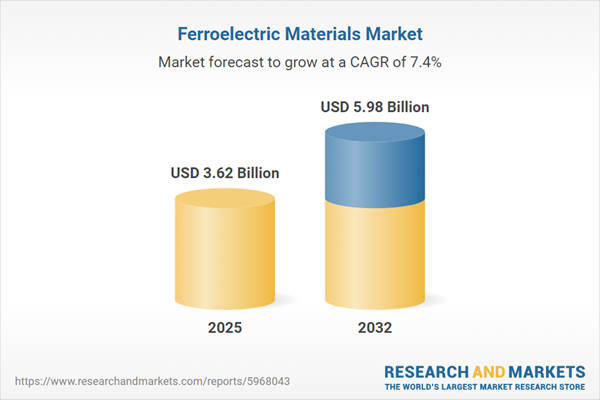Speak directly to the analyst to clarify any post sales queries you may have.
The ferroelectric materials market is witnessing significant advancement, driven by innovations in materials science, sustainability mandates, and increased cross-industry adoption. This research offers strategic clarity to senior decision-makers seeking reliable, actionable intelligence to capitalize on growth and mitigate risks in this evolving global sector.
Market Snapshot: Ferroelectric Materials Market Growth and Dynamics
The Ferroelectric Materials Market grew from USD 3.39 billion in 2024 to USD 3.62 billion in 2025, with expectations to reach USD 5.98 billion by 2032 at a CAGR of 7.36%.
Strong demand is fueled by trends in miniaturization, energy efficiency, and the transition to sustainable material alternatives. Increasing regulatory pressures and the integration of ferroelectric materials into cutting-edge electronics, automotive systems, and medical devices are reshaping supply chains and competitive strategies.Scope & Segmentation of the Ferroelectric Materials Market
This report offers a granular view of the market, categorizing key segments and regional profiles while revealing pivotal growth drivers and innovation trajectories.
- Material Types: Barium Titanate, Bismuth Ferrite, Lead Titanate, Lead Zirconate Titanate, Polyvinylidene Fluoride (PVDF)
- Production Processes: Chemical Vapor Deposition, Crystallization Methods, Sol-Gel Process
- Applications: Actuators, Capacitors, Memory Devices, Sensors
- End-Users: Aerospace & Defense, Automotive, Consumer Electronics, Industrial Machinery, Medical Devices, Telecommunications
- Regions Covered: Americas (including United States, Canada, Mexico, Brazil, Argentina, Chile, Colombia, Peru), Europe, Middle East & Africa (United Kingdom, Germany, France, Russia, Italy, Spain, Netherlands, Sweden, Poland, Switzerland, United Arab Emirates, Saudi Arabia, Qatar, Turkey, Israel, South Africa, Nigeria, Egypt, Kenya), Asia-Pacific (China, India, Japan, Australia, South Korea, Indonesia, Thailand, Malaysia, Singapore, Taiwan)
- Leading Companies: American Elements, APC International Ltd., Arkema Group, CeramTec GmbH, CTS Corporation, Fuji Titanium Industry Co. Ltd., Inframat Advanced Materials LLC, KCM Corporation, KYOCERA Corporation, Merck KGaA, Nippon Chemical Industrial Co. Ltd., PI Ceramic GmbH, Piezo Kinetics Inc., Piezo Technologies, ProChem Inc., Reade International Corp., Sakai Chemical Industry Co. Ltd., Shandong Sinocera Functional Materials Co. Ltd., Shanghai Dian Yang Industrial Co. Ltd., Solvay S.A., Thermograde Process Technology Ltd., Titanates Ltd., Vibrantz Technologies Inc.
Key Takeaways for Senior Decision-Makers
- Market adoption is pivoting strongly towards sustainable, lead-free ferroelectric compositions, with regulatory compliance and performance forming key decision criteria for procurement and R&D investment.
- Advanced manufacturing processes such as additive manufacturing, high-precision sol-gel synthesis, and scalable vapor-phase crystallization are critical in delivering reliable, application-specific film properties.
- Collaboration across industries—particularly partnerships between material suppliers, device manufacturers, and end-users—is accelerating innovation cycles and enabling faster commercialization of next-generation devices.
- Regional initiatives, including focused public-private investments in Asia-Pacific and regulatory-led shifts in Europe, shape demand and foster new applications, particularly in automotive electrification, semiconductor integration, and medical device innovation.
- The market’s segmentation highlights distinct technical requirements and opportunities in each end-user vertical, from high-performance aerospace actuators to flexible electronics and telecommunications filters.
Tariff Impact on Supply Chain and Competitiveness
Recent U.S. tariff policies have increased input costs for key precursor chemicals and imported wafers. In response, producers are enhancing vertical integration and adjusting sourcing strategies to control volatility. These moves are reshaping global supply chains, encouraging regionalization, and prompting co-development of tariff-immune material blends, directly affecting cost structures and partnership models for industry leaders.
Methodology & Data Sources
This research draws on a robust combination of structured executive interviews, secondary validation through scientific publications and trade databases, and advanced analytical modeling. Scenario stress-testing and network analysis illuminate industry collaboration patterns, while data integrity is ensured via triangulation and multi-stage verification across benchmarks.
Why This Report Matters
- Enables executive teams to make informed, strategic decisions on investments, R&D, and supplier relationships in a rapidly changing technical landscape.
- Maps new opportunities and competitive threats arising from technology trends, regulatory shifts, and regional market dynamics.
- Delivers dependable, segment-specific guidance for market entry, risk mitigation, and long-term growth planning.
Conclusion
The ferroelectric materials market is entering a period of sustained transformation, shaped by innovation, regulation, and collaborative dynamics. Executives equipped with forward-looking insights will be best positioned for resilience and growth in this evolving sector.
Additional Product Information:
- Purchase of this report includes 1 year online access with quarterly updates.
- This report can be updated on request. Please contact our Customer Experience team using the Ask a Question widget on our website.
Table of Contents
3. Executive Summary
4. Market Overview
7. Cumulative Impact of Artificial Intelligence 2025
Companies Mentioned
The companies profiled in this Ferroelectric Materials market report include:- American Elements
- APC International, Ltd.
- Arkema Group
- CeramTec GmbH
- CTS Corporation
- Fuji Titanium Industry Co., Ltd.
- Inframat Advanced Materials, LLC
- KCM Corporation
- KYOCERA Corporation
- Merck KGaA
- Nippon Chemical Industrial Co., Ltd.
- PI Ceramic GmbH
- Piezo Kinetics, Inc.
- Piezo Technologies
- ProChem, Inc.
- Reade International Corp.
- Sakai Chemical Industry Co., Ltd.
- Shandong Sinocera Functional Materials Co., Ltd.
- Shanghai Dian Yang Industrial Co. Ltd.
- Solvay S.A.
- Thermograde Process Technology Ltd.
- Titanates Ltd.
- Vibrantz Technologies Inc.
Table Information
| Report Attribute | Details |
|---|---|
| No. of Pages | 188 |
| Published | November 2025 |
| Forecast Period | 2025 - 2032 |
| Estimated Market Value ( USD | $ 3.62 Billion |
| Forecasted Market Value ( USD | $ 5.98 Billion |
| Compound Annual Growth Rate | 7.3% |
| Regions Covered | Global |
| No. of Companies Mentioned | 24 |









